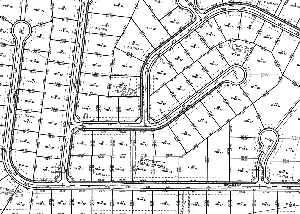Earlier in the decade, the housing market was hot. Landowners with visions of dollars dancing in their heads lined up to subdivide large parcels. It seemed like a new residential development was proposed every month in Woodstock. Yet the pace here was slow compared with many other towns. The Killingly Inland Wetlands & Watercourses Agency had 26 applications in one month alone, most of which were for subdivisions. For all of Windham County, annual housing permits peaked in 2005, with 593 issued. (Source: CT DECD)
 |
Many subdivisions are named for what they replaced, such as “Whispering Pines,”“Green Meadows,” or “Valleybrooke Farm.” Planner Randall’s Arendt’s personal favorite was a subdivision named Dutch Elm (disease.) See next week’s article for steps anybody can take to help conserve open space. |
Then came the banking debacle and stock market decline. As foreclosures soared, consumer confidence sank. The recession drove prices of existing houses and vacant lots down. In the space of one year, the number of housing permits issued in 2007 in Windham County dropped by half , to 303. In 2008, it slid even further to 171.
Decreased property values have had interesting side effects. Existing houses have become more affordable. Buyers willing to invest sweat equity may be able to buy a place and still have some cash left over to fix it up. As a result, a number of neglected or deteriorating properties are being renovated. This will ultimately increase their value, along with the value of neighboring homes.
During the downturn, some owners of large parcels are hanging onto them. They realize that real estate values tend to go in cycles, and will probably rise again within a decade. However, cash-strapped owners may feel they can’t afford to wait for the market to turn around before the sell, especially for properties that do not produce any revenue. The recession has negatively impacted incomes and retirement accounts. For the self-employed, land may BE their retirement fund and/or insurance policy.
Other large premium parcels on the market appear to be “protected by greed” when their owners ask exorbitant prices. Generally, there are only two types who can afford to buy these properties. One is the uber-wealthy. In post-Bernie Madoff days, these types are fewer and farther between. The other is a developer, who will but it as an investment and plans to split the land up. They may put as many lots on the land as local zoning allows, in order to maximize profits.
Many people who inherited large parcels or accumulated a lot of land when it was relatively cheap are now in their 60s or older. They may envision the land that had been forested or farmed for generations staying that way forever. But if they don’t put it in writing, once they are gone, the land is up for grabs. Their heirs may live far away, have no interest in working the land, may not be able to afford the taxes, or won’t be able to agree on who gets what. They may divide it up or sell it off in a heartbeat.
Some towns are “economizing” by cutting back on funding for open space or conservation easements purchases. A proposal is even floating around the City of Hartford to sell Batterson Park to help balance the books. “When times get tough, it’s tempting but imprudent to part with the family jewels,” noted an editorial in the Hartford Courant. Once lost, they are generally gone forever.
When we look around rural towns in Northeastern CT, it may seem like there is still plenty of land that is “open,” even if it is not committed open space. However, we may be failing to appreciate the forest for the trees. Keep in mind that towns such as Rocky Hill and East Hartford once looked just like this. Make no mistake – we are in the midst of a temporary reprieve from residential development.
Think about that big plot of privately-owned farmland or forest that you love to live near or pass by. It could change forever, before your very eyes. Instead of vast meadows or woods filled with wildlife and clean streams, imagine a subdivision packed with plastic houses. Or a big box store with a giant parking lot. A tattoo parlor or strip joint may not be out of the question. Or maybe an outdoor concert arena, an ATV track, a cell tower, a prison, or a rock crushing operation. The possibilities are endless. “People who superimpose their interests on other people’s land are bound to be disappointed at least some of the time when that person puts their own ‘plans’ into action,” notes Woodstock Town Planner Delia Fey.
Connecticut has been losing open space at twice the rate of the national average. As Mark Twain noted, they’re not making land anymore. If you want to protect open space, you’d better do something about it – NOW.
See Part II - What Ordinary People Can Do to Conservation Open Space |

